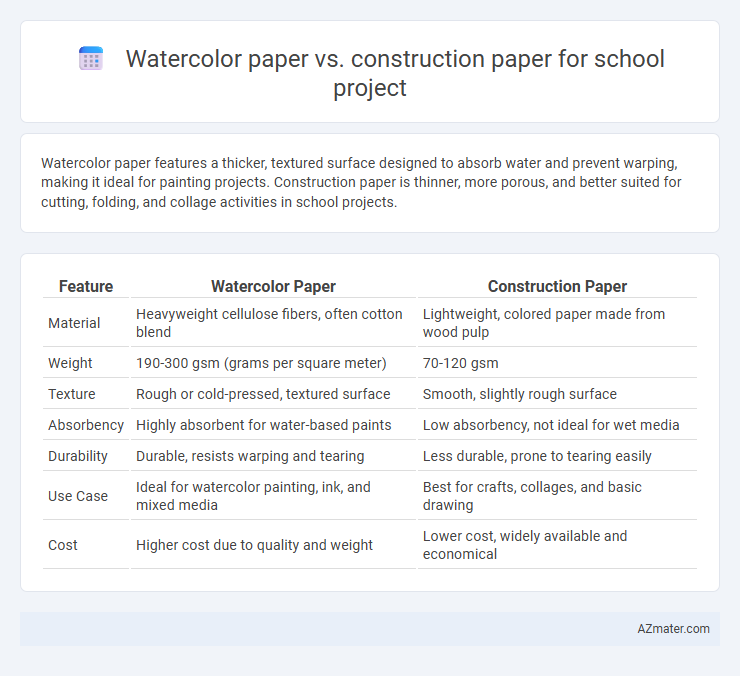Watercolor paper features a thicker, textured surface designed to absorb water and prevent warping, making it ideal for painting projects. Construction paper is thinner, more porous, and better suited for cutting, folding, and collage activities in school projects.
Table of Comparison
| Feature | Watercolor Paper | Construction Paper |
|---|---|---|
| Material | Heavyweight cellulose fibers, often cotton blend | Lightweight, colored paper made from wood pulp |
| Weight | 190-300 gsm (grams per square meter) | 70-120 gsm |
| Texture | Rough or cold-pressed, textured surface | Smooth, slightly rough surface |
| Absorbency | Highly absorbent for water-based paints | Low absorbency, not ideal for wet media |
| Durability | Durable, resists warping and tearing | Less durable, prone to tearing easily |
| Use Case | Ideal for watercolor painting, ink, and mixed media | Best for crafts, collages, and basic drawing |
| Cost | Higher cost due to quality and weight | Lower cost, widely available and economical |
Introduction: Choosing the Right Paper for School Projects
Watercolor paper offers a textured surface designed to handle wet media, making it ideal for vibrant, detailed art projects requiring paint or water-based markers. Construction paper provides an affordable, smooth finish suited for cutting, folding, and collaging in various craft activities. Selecting the right paper depends on the medium used and the desired durability and visual effect in your school project.
What is Watercolor Paper? Key Features and Benefits
Watercolor paper is a specially designed paper that features a heavier weight and a textured surface, allowing it to absorb water and pigments effectively without warping. Key features include high absorbency, durability, and a rough or cold-pressed texture that enhances color blending and detail in watercolor painting. Benefits for school projects include superior color vibrancy, less bleeding, and a professional finish that supports various wet media techniques.
What is Construction Paper? Characteristics and Uses
Construction paper is a heavy-weight, coarse paper often used in school projects for its affordability and vibrant colors. Its textured surface allows for easy cutting, gluing, and folding, making it ideal for crafts, collages, and simple art projects. Construction paper is less absorbent than watercolor paper, so it is not suitable for wet media but excels in dry media applications like crayons and markers.
Texture and Surface Quality Comparison
Watercolor paper features a textured, absorbent surface designed to hold and distribute pigments evenly, preventing warping and allowing for intricate blending effects. Construction paper has a smoother, less absorbent surface that can cause watercolors to pool or smear, often resulting in uneven color application. For school projects requiring vibrant, consistent watercolor outcomes, the textured quality of watercolor paper provides superior durability and visual appeal compared to the flat surface of construction paper.
Absorbency and Paint Compatibility
Watercolor paper offers superior absorbency, allowing it to hold wet paint without warping or bleeding, making it ideal for watercolor paints and other water-based mediums. Construction paper, with its lower absorbency and rough texture, is better suited for dry media like crayons and markers but tends to buckle or tear when exposed to wet paint. For school projects involving wet paint techniques, watercolor paper ensures vibrant colors and cleaner edges due to its composition and size specifically designed to manage moisture.
Durability and Strength: Which Paper Lasts Longer?
Watercolor paper is engineered with thicker fibers and higher weight, typically ranging from 140 lb (300 gsm) to 300 lb (640 gsm), providing superior durability and resistance to warping or tearing during painting. Construction paper, usually lighter at around 50-70 lb (74-104 gsm), is more prone to ripping and fading over time, making it less ideal for projects requiring longevity. For school projects demanding lasting strength and preservation, watercolor paper offers significantly better durability and structural integrity.
Color Vibrancy: Watercolor Effects vs. Solid Colors
Watercolor paper enhances color vibrancy by allowing pigments to blend and spread, creating rich, dynamic watercolor effects ideal for artistic school projects. Construction paper offers solid, opaque colors with a matte finish, providing consistent, bright hues but lacks the fluidity and depth achieved with watercolor techniques. Selecting watercolor paper is essential for projects emphasizing color gradients and texture, while construction paper suits projects requiring bold, uniform coloration.
Cost and Availability: Budget Considerations for Schools
Watercolor paper typically costs more than construction paper due to its specialized texture and durability, making it less budget-friendly for large school projects. Construction paper is widely available and affordable in bulk, which suits schools with limited budgets seeking economical art supplies. Budget-conscious schools prioritize construction paper to maximize quantity without sacrificing basic quality for student projects.
Best Uses: Ideal Projects for Watercolor and Construction Paper
Watercolor paper is best suited for projects involving wet media such as watercolor paints because it absorbs moisture without warping or tearing, making it ideal for detailed paintings, mixed media art, and texture experiments. Construction paper is perfect for dry media and craft projects like cutting, folding, and collage work due to its sturdy texture and vibrant colors, making it suitable for posters, greeting cards, and paper sculptures. Choosing the right paper ensures the success of specific school projects by matching the material's strength and absorbency to the intended artistic technique.
Conclusion: Making the Best Choice for Your School Project
Watercolor paper offers superior durability and texture, making it ideal for projects involving wet media and detailed artwork. Construction paper provides affordability and vibrant colors, suitable for simple crafts and quick projects. Choosing between them depends on your project's artistic requirements and budget constraints to achieve the best outcome.

Infographic: Watercolor paper vs Construction paper for School project
 azmater.com
azmater.com